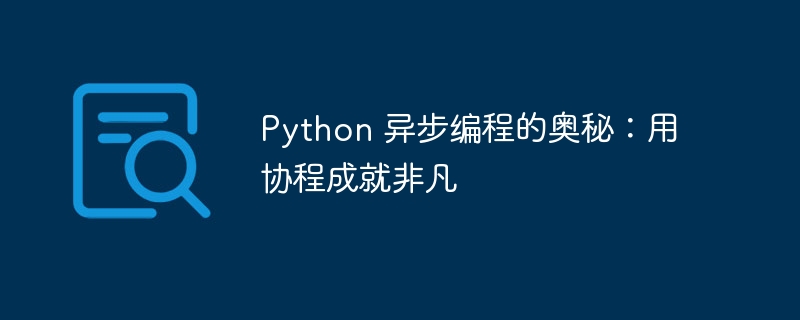Home >Backend Development >Python Tutorial >The secret of asynchronous programming in Python: Achievements with coroutines
The secret of asynchronous programming in Python: Achievements with coroutines
- WBOYWBOYWBOYWBOYWBOYWBOYWBOYWBOYWBOYWBOYWBOYWBOYWBforward
- 2024-03-12 08:10:27662browse

Basic principles of coroutines
A coroutine function, also known as a generator function, is a special function that pauses its execution and returns a value. When it is time to continue execution, the coroutine function can use the yield statement to send the value to the caller and pause itself. The caller can later resume the execution of the coroutine function by calling the next() method to obtain the next value returned by the coroutine function.
In python, a coroutine is declared with the async def keyword and its execution is paused using the aw<strong class="keylink">ai</strong>t keyword . The await statement returns control to the event loop, allowing other coroutines or tasks to execute. When the suspended task is completed, the event loop will automatically resume the execution of the suspended coroutine function.
Event Loop The event loop is a key component in Python for handling asynchronous events. It continuously polls the event queue and reacts to events in the queue. When a coroutine function pauses execution, it adds itself to the event queue. The event loop handles events in the queue, such as Network requests or timer events, and resumes execution of the coroutine function after the event completes.
Benefits of coroutines Using coroutines for asynchronous programming has many benefits, including:
- Non-blocking: Coroutines allow concurrent execution of tasks without blocking the main thread . This is critical for applications that need to handle a large number of requests or events simultaneously.
- High performance: Coroutines avoid the overhead of thread creation and context switching, thereby improving the overall performance of the application.
- Scalability: Coroutines can be easily scaled to handle large numbers of concurrent connections or tasks without major modifications to the code.
- Maintainability: Asynchronous code written using coroutines is generally easier to understand and maintain than using threads or callbacks.
Advanced coroutine technology
In addition to basic coroutines, Python also provides a series of advanced coroutine technologies to further enhance the capabilities of asynchronous programming. These technologies include:
- async/await: async/await
syntax was introduced in Python 3.5, providing a cleaner, easier-to-use coroutine syntax. - asyncio: asyncio is Python’s standard asynchronous I/O library that provides support for sockets, processes, and event loops.
- Coroutine pool: The coroutine pool can manage the execution of coroutines to ensure that the number of coroutines running simultaneously does not exceed the predefined limit.
Practical Application Coroutines are widely used in various fields, including:
- Web framework: Asynchronous WEB Framework, such as flask and Django, use coroutines to process Concurrent Http requests.
- Data processing: Coroutines can be used to process big data sets in parallel to improve data processing speed.
- Network programming: Coroutines are used to establish asynchronous network servers and clients to achieve high-performance network communication.
- Machine Learning: Coroutines can be used to accelerate the training and inference process of Machine Learning models.
in conclusion Coroutines are the cornerstone of asynchronous programming in Python, and they enable developers to write high-performance, high-concurrency applications. Through coroutines, developers can make full use of the event loop to efficiently handle concurrent tasks in a non-blocking manner. Advanced coroutine technology further enhances the capabilities of coroutines, making them valuable tools in a wide range of application domains.
The above is the detailed content of The secret of asynchronous programming in Python: Achievements with coroutines. For more information, please follow other related articles on the PHP Chinese website!

